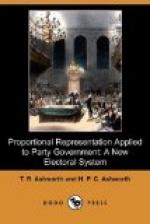In dividing a State into electorates for the purpose of the reform, the number of electors in each division should therefore form the basis of proportional distribution. The unit of representation would be the total number of electors in the State divided by the number of seats. One representative would be allowed to each division of the State for each unit of representation, and the remaining seats, if any, would go to those divisions with the largest remainders.
Coming now to the Federal Senate, the bill provides that every State, except Queensland, must be polled as one electorate for the election of six senators at the first election and in case of a double dissolution; at intermediate elections three senators only will be elected, as they retire in rotation. This equal representation of the States might be taken to imply that the Senate is intended to represent State rights, and the provision that each State is to be polled as one electorate would seem to support that view. On the other hand, the senators are not required to vote according to States, for it is provided that “each senator shall have one vote;” the vote of a State may therefore be neutralized by its representatives. And again, the Senate is to be elected directly by the people and not by the State legislatures, as at first proposed. To some extent, therefore, the Federal Senate as now constituted presents a new problem in representation, on which it is not advisable to dogmatize. Personal considerations will probably have more weight than in the selection of representatives; but when we reflect that it is really little more than a revising assembly, elected by the same voters as the House of Representatives to deal with the same questions, and having no special functions of its own, the conclusion seems irresistible that the election must be contested by the same national parties, and that the same method of election should be adopted.
Until the Parliament of the Commonwealth prescribes a uniform method of choosing senators, the duty is to be left to the State parliaments; and it is to be regretted that the States have taken no steps to secure uniform action at the first election. In Victoria a fierce newspaper contest is being waged over the Block Vote and the Hare system, and the arguments, being mutually destructive, only go to prove that both are equally objectionable. The Age naturally wishes to have the privilege of electing six senators as it did ten delegates to the Federal Convention, and contends that the majority should elect all the senators; the Argus rushes to the other extreme in declaring that six separate minorities ought to be represented, and ignores the risk that these minorities would be formed on a class or religious basis. The middle position advocated in this book—namely, that majority and minority should each return its proportional share of representation—is free from the objections to both these extreme views.




